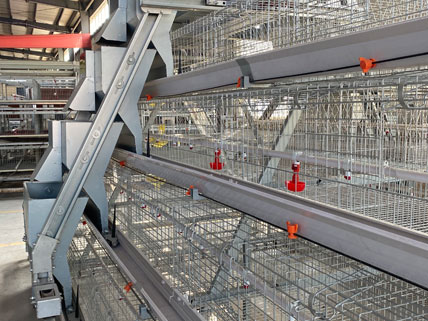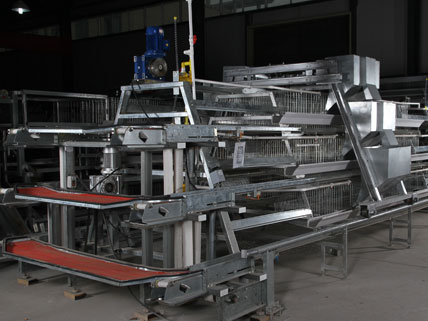Improving Animal Welfare With Deep Litter Poultry House Design
Deep litter poultry housing is a method of cage-free housing that involves using a deep layer of litter on the floor of the house, typically made up of materials such as straw, sawdust, or wood shavings. This method has become increasingly popular in recent years due to its many benefits for both poultry and farmers.
One of the main benefits of deep litter poultry house design is improved animal welfare. With a deep layer of litter on the floor, birds can engage in natural scratching and foraging behaviors, which helps to reduce stress and improve their overall health and well-being. Additionally, the litter provides insulation, helping to keep the birds warm in cooler weather and cool in warmer weather.
Another benefit of deep litter poultry house design is reduced labor costs. With a deep litter system, the litter can be left in place for several months before needing to be completely replaced, saving farmers time and money on cleaning and maintenance.
Overall, deep litter poultry house design is a cost-effective and humane method of housing poultry that offers numerous benefits for both farmers and their birds. In the following sections, we'll take a closer look at the design considerations and maintenance required for a successful deep litter poultry house.
Understanding Deep Litter Poultry House Design
Deep litter poultry house design involves using a deep layer of litter on the floor of the poultry house, typically around 6-8 inches deep. The litter is made up of materials such as straw, sawdust, or wood shavings, which provide a soft and absorbent surface for the birds to walk and rest on.
One of the key benefits of using deep litter is that it helps to reduce ammonia levels in the house. Ammonia can build up quickly in poultry houses and can be harmful to birds, causing respiratory problems and other health issues. The litter helps to absorb the ammonia, reducing its concentration in the air and improving the overall air quality in the house.
In addition to improving air quality, deep litter poultry house design can also help to improve bird health. The litter provides a natural environment for birds, allowing them to engage in natural scratching and foraging behaviors. This can help to reduce stress and prevent behavioral problems such as feather pecking and cannibalism.
When it comes to choosing the right litter material, there are a few factors to consider. Straw, sawdust, and wood shavings are all common materials used for deep litter, but each has its own advantages and disadvantages. For example, straw is inexpensive and easy to source, but it can be difficult to manage and may not provide as much absorbency as other materials. Sawdust and wood shavings are more absorbent, but they can be more expensive and may require more frequent cleaning.
Overall, deep litter poultry house design is an effective and natural way to house poultry that offers numerous benefits for both birds and farmers. In the next section, we'll take a closer look at the design considerations for a successful deep litter poultry house.
Design Considerations
When it comes to designing a deep litter poultry house, there are several important considerations to take into account to ensure the health and well-being of the birds.
Ventilation
Proper ventilation is crucial in a deep litter poultry house to maintain good air quality and prevent the buildup of harmful gases such as ammonia and carbon dioxide. Adequate ventilation can be achieved through natural ventilation, such as windows and vents, or mechanical ventilation, such as fans.
Lighting
Appropriate lighting is important in a deep litter poultry house to ensure that birds have access to enough light for optimal growth and development. Natural lighting can be supplemented with artificial lighting, particularly in the winter months when daylight hours are shorter.
Insulation
Proper insulation is essential in a deep litter poultry house to help maintain a comfortable temperature for the birds. Adequate insulation can help to keep the house warm in the winter and cool in the summer, reducing stress on the birds and promoting better overall health.
Water Supply
Access to clean and fresh water is critical for the health and well-being of the birds. Water lines should be checked regularly to ensure that they are functioning properly, and water should be changed frequently to prevent contamination.
Floor Design
The design of the floor is important in a deep litter poultry house to ensure that the litter remains dry and comfortable for the birds. Concrete floors are common, but they can be slippery and may require non-slip surface treatment. Other options include plastic or wire mesh floors, which can help to promote better litter quality and reduce the risk of disease.
By taking these design considerations into account, farmers can create a deep litter poultry house that provides a healthy and comfortable environment for their birds, improving animal welfare and reducing labor costs. In the next section, we'll take a closer look at the maintenance required for a successful deep litter poultry house.
Building a Deep Litter Poultry House
Building a deep litter poultry house requires careful planning and attention to detail. Here are some step-by-step instructions to guide you through the process:
Determine the size and layout: The first step in building a deep litter poultry house is to determine the size and layout. Consider the number of birds you plan to house, as well as the space required for feeders, waterers, and other equipment.
Choose the right location: Select a location for the poultry house that is well-drained and free from flooding. Also, ensure that it is accessible for feed and water delivery, as well as for manure removal.
Gather materials: The materials needed for a deep litter poultry house include lumber, roofing material, wire mesh, and insulation. You'll also need nails, screws, and other fasteners, as well as specialized tools like a saw, drill, and hammer.
Build the frame: Start by building the frame of the poultry house using lumber. This will provide the structure for the walls and roof.
Install insulation: Once the frame is complete, install insulation to help regulate the temperature inside the house.
Add roofing material: Next, add roofing material to protect the birds from the elements. A metal roof is a popular choice as it is durable and long-lasting.
Install windows and vents: Install windows and vents to provide natural light and ventilation.
Add wire mesh: To keep the birds contained, add wire mesh to the walls and floor of the poultry house.
Add litter material: Add the litter material of your choice, such as straw or sawdust, to the floor of the poultry house to a depth of at least six inches.
Add feeders and waterers: Finally, add feeders and waterers to provide the birds with food and water.
Building a deep litter poultry house requires some basic carpentry skills and specialized tools. However, with careful planning and attention to detail, it is a task that can be completed by most farmers. Consult with local experts or professionals for specific advice or help with building a deep litter poultry house.
Maintaining a Deep Litter Poultry House
Maintaining a deep litter poultry house is critical for ensuring the health and well-being of your birds. Here are some maintenance tasks to keep in mind:
Litter management: The litter in a deep litter poultry house should be regularly turned and stirred to prevent clumping and promote the absorption of moisture. This helps reduce the risk of disease and ammonia buildup.
Cleaning: It's important to regularly clean the poultry house to remove any buildup of manure, feathers, or other debris. This helps prevent disease and keep the birds healthy.
Pest control: Pests like rodents, mites, and flies can be a significant problem in a poultry house. Regular monitoring and control measures, such as trapping, baiting, or insecticide treatments, can help keep pests under control.
Ventilation: Proper ventilation is essential for maintaining good air quality inside the poultry house. Ensure that the vents and fans are working correctly, and clean them regularly to prevent clogs and blockages.
Water and feed management: Provide the birds with clean, fresh water and feed daily. Ensure that the waterers and feeders are regularly cleaned to prevent the buildup of bacteria.
Monitoring bird health: Regularly monitor the birds for signs of disease or illness, such as coughing, sneezing, or lethargy. If any issues are detected, consult with a veterinarian or other poultry health expert.
By following these maintenance tasks, you can help ensure that your deep litter poultry house remains in good condition and your birds remain healthy and happy.
Conclusion
Deep litter poultry house design is an excellent way to provide a healthy and comfortable environment for your birds. By using natural materials for litter and carefully considering design and maintenance considerations, you can help reduce labor costs, improve animal welfare, and increase overall production.
When designing and building your deep litter poultry house, keep in mind the importance of proper ventilation, lighting, insulation, and litter management. These factors can have a significant impact on the health and productivity of your birds.
Regular maintenance is also essential for keeping your poultry house in good condition. By following the recommended maintenance tasks, you can help prevent disease, pests, and other issues that can negatively impact your birds' health.
Overall, deep litter poultry house design is an excellent investment for poultry farmers looking to improve their operations' efficiency and animal welfare. With careful planning and attention to detail, you can create a comfortable and healthy environment for your birds that will benefit both you and your feathered friends.

 Rre
Rre







Post your divine reply